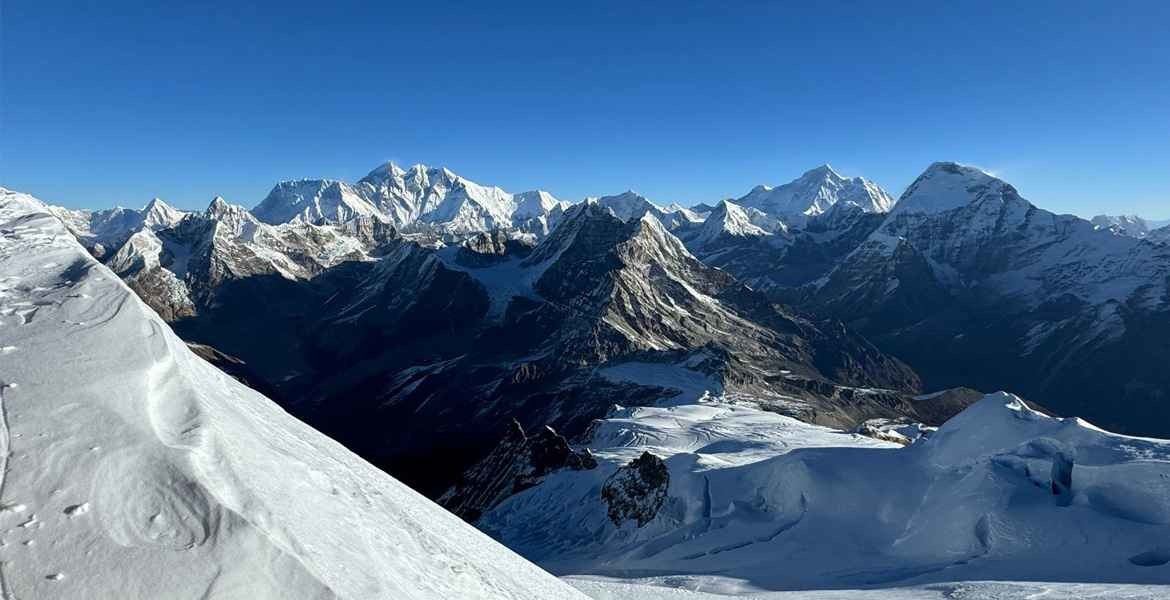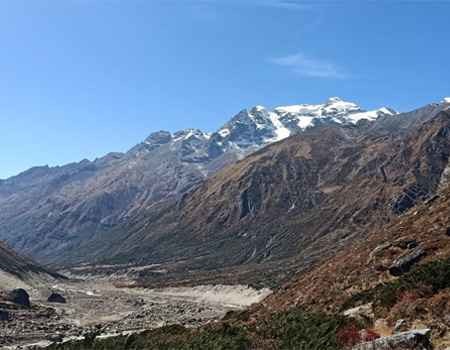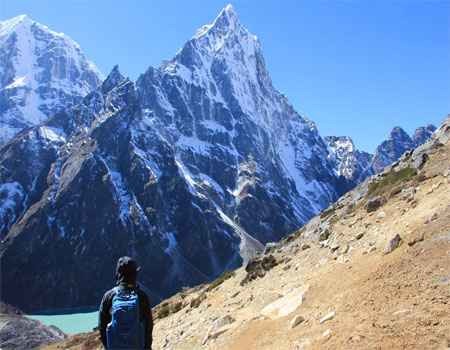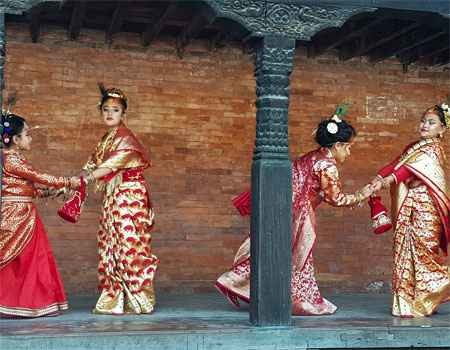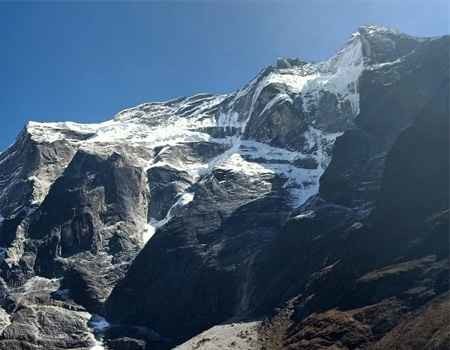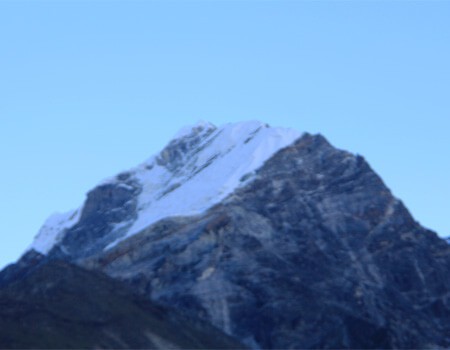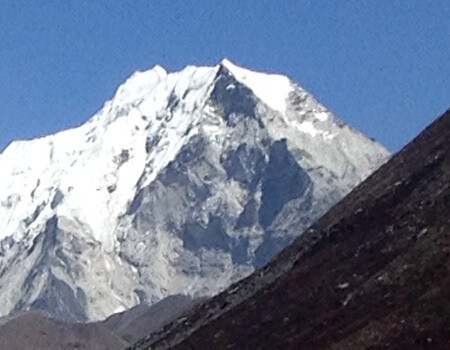Mera Peak is one of Nepal's most popular and highest trekking peaks, with an elevation of 6,476 meters from sea level. To ensure safety, enjoy favorable weather, and maximize the overall experience, choose the right season to climb Mera Peak. This blog post provides detailed information on the best seasons to climb Mera Peak, including weather conditions, scenery, advantages, challenges, and cultural highlights.
Spring (March to May)

Everest View in Spring
Spring is the primary season to climb mountains, including Mera Peak, due to its stable weather, favorable temperatures, and scenic beauty. Check more about the weather, scenery, perks, and difficulties below:
Weather
Daytime temperatures at lower altitudes range from 10°C to 15°C. In comparison, higher elevations can drop to -10°C to -15°C during a climbing trip to Mera Peak. When you know about the information about weather and temperatures, it makes it easier to pack trekking and climbing gear.
Clear skies and consistent weather patterns dominate this season, reducing risks of sudden disruptions. However, the hazy surroundings in April might affect long-distance visibility; still, some raindrops or wind might clear obstacles to visibility due to the haze.
Scenery
Rhododendrons bloom with vibrant colors in spring, creating picturesque landscapes throughout the trek in lower areas of the Mera Region. From the second week of April to May, we can see them blooming in various shades.
From the summit of Mera Peak, views of towering Himalayan peaks like Everest, Lhotse, Makalu, Cho-Oyu, and Kanchenjunga are crystal clear during this time.
Advantages
As mentioned earlier, spring is a primary season for peak climbing and expeditions. Why do people attempt adventure mountain trips for the summit this season? For a reason, check them below:
- Stable snow conditions make navigation safer and reduce avalanche risks.
- Spring offers a lively atmosphere with many climbers on the trail, fostering camaraderie among adventurers.
Challenges
There are good and bad things everywhere! As mentioned earlier about the advantages of climbing Mera Peak in spring, visitors still face difficulties and challenges. What are the challenges that can occur while climbing Mera Peak? Check them below:
- Crowded trails may diminish the sense of solitude for some climbers.
- Unpredictable snowstorms can occasionally arise early or late in the season.
Festivals Celebration in Spring
There are some vibrant cultural festival celebrations in Nepal during the spring season. You can join the locals and celebrate those festivals in Kathmandu before or after your Mera Peak expedition. So, choose the spring season to climb Mera Peak in Nepal. You may have a cultural and religious experience with adventure.
Holi (February/March): Holi is the festival of colors that marks the arrival of spring with joyous festivities. Thousand of foreigners come to Nepal every year to celebrate Holi. You may have heard about this festival and have seen some photos and videos. Still, you have never had the chance to participate in and enjoy this festival with the locals, so a spring climb to Mera Peak can be the best opportunity.
Bisket Jatra (April): The Bisket Festival is a celebration that lasts a few days in Bhaktapur inside Kathmandu Valley around the Nepali New Year. Hundreds of people pull a big wooden chariot, making it look like a temple, play cultural Newar instruments, and wear colorful traditional dresses and ornaments. You can also participate in this extraordinary festival when you come to Nepal in spring to climb Mera Peak.
Buddha Jayanti (April/May): Buddha Jayanti is a Buddhist Festival, but the Hindus of Nepal also respect and celebrate it. It is a one-day festival on a full moon day in April/May (mainly in May). The Buddha Jayanti is also known as Baishakh Purnima. We mostly see the celebrations in Buddhist Sites and monasteries, so you can join the festival and celebrate with the locals and monks while on the Mera Peak trip in the spring.
These festivals provide unique opportunities to engage with local traditions and enjoy cultural immersion during your spring trekking and climbing trip to Mera Peak.
Autumn (September to November)
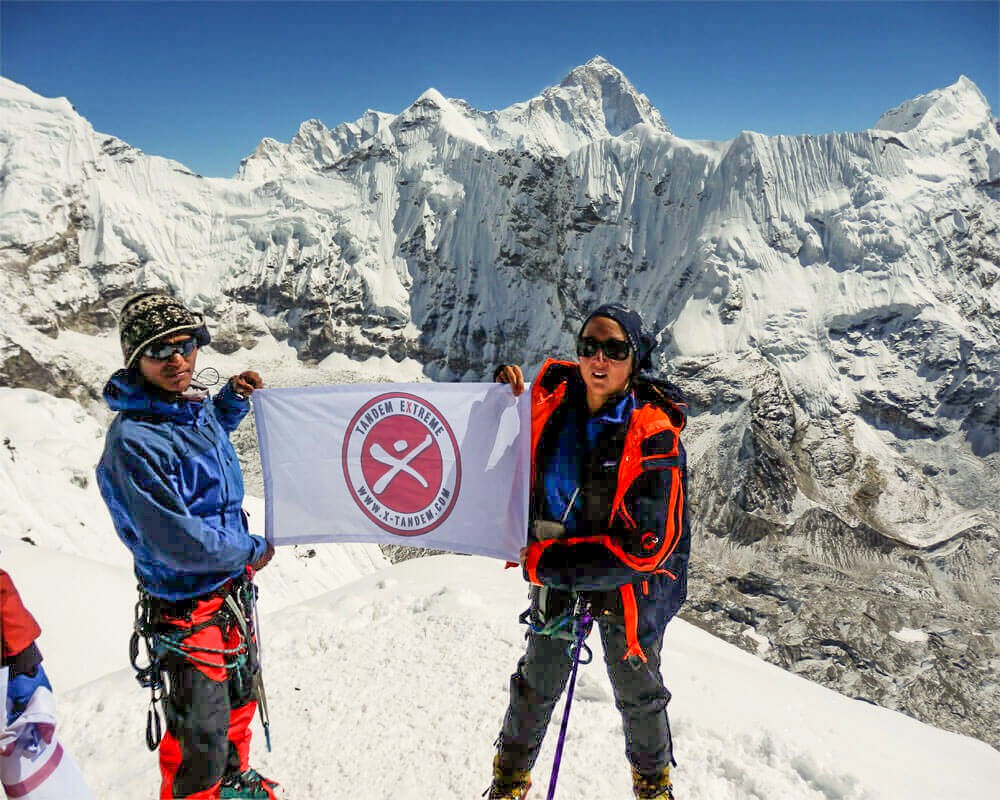
Autumn Summit
Autumn is another ideal season for trekking in Nepal and climbing Mera Peak. The temperature remains colder compared to spring and autumn. So, autumn is not the primary season for climbing and expeditions; the weather conditions are far better now. It will be bright surroundings, blue skies with breathtaking views even for a long distance, and almost no rain. However, the first half of September may have rainy days in Nepal.
Weather
In autumn, daytime temperatures will range from 10°C to 15°C at lower elevations and -10 to -20°C at higher altitudes. Still, they will drop to colder temperatures after the second half of November. We suggest packing warmer clothes for autumn compared to spring before you head on to climb Mera Peak.
The autumn season comes right after the summer monsoon season, so lots of rain during the monsoon season clears the environment with clean air and unobstructed views of the mountains. You can see bright, shiny white mountains even from a long distance and Kathmandu in autumn.
Scenery
Autumn offers crystal weather conditions. The trekking trails in Nepal will have a bigger crowd at this time because of the fresh-looking nature, blue skies, and long-distance Himalayan views. The trails during the autumn months are dry and easy to navigate after the monsoon rains.
During this time, you can see panoramic, stunning Himalayan peaks from most hill stations and even Nepal's major cities, Kathmandu and Pokhara.
Advantages
We have declared autumn the best trekking season in Nepal for several reasons. So, you can benefit from bright views, fresh air quality, and perfect temperatures for walking in Nepal's mountain regions, including the Mera Peak. What are the perks of making a trip to Mera Peak for trekking and climbing? Check them below:
- Predictable weather patterns make planning easier and enhance safety on the climb.
- The walking trails are not slippery in autumn compared to the monsoon and winter seasons.
Challenges
As we described earlier about the advantages and challenges of spring climbing Mera Peak, autumn also has some difficulties with its good things. Let's check about the challenges of climbing Mera Peak in the autumn here:
- High footfall during peak autumn months can lead to crowded routes.
- Early snowfall in late November may pose difficulties for climbers unprepared for colder conditions.
Festival Celebration in Autumn
Autumn is the season with the most important festivals in Nepal. Nepal is a country with a majority of Hindus, so the two biggest festivals of Hindus are in the autumn season. You can join locals of see celebrating these great festivals with lights and more while you are on a climbing trip to Mera Peak in autumn in Nepal.
Dashain (September/October): Dashain, also known as Vijaya Dashami, is Nepal's most prominent Hindu festival celebration, the triumph of good over evil. Many people work in the bigger cities in Nepal and abroad from the villages and return to join their families for this festival. In urban areas of Nepal, it is better to celebrate the Dashain Festival. Still, the Mera Region has the majority of Buddhists, and you can barely see the celebration of this festival. You can participate in this festival in the family of the team of Frolic Adventure before or after your Mera Peak trip in Kathmandu.
Tihar (October/November): The Tihar, known as Diwali or Dipawali, is the festival of lights. The five-day festival honors animals like crows, dogs, oxs, and cows alongside Goddess Lakshmi. It is one of the most unique festivals for siblings. The houses glow with oil lamps, candles, and colorful electric lights during this time. You can see the celebrations of this festival all over Nepal. Still, the cities look more decorative with the lights in Tihar. It is mainly a Hindu festival, but Buddhist and Kirant people also join the festival to sing and dance and collect donations, which is called the Deusi Bhailo festival.
These festivals add a cultural dimension to your climb by offering chances to witness traditional Sherpa celebrations on the Mera Peak route. But we suggest being in Kathmandu during Tihar before or after your Mera Trip.
While spring and autumn are preferred for climbing Mera Peak, other seasons—winter and summer/monsoon—are also options but come with significant challenges.
Winter (December to February)
Winter climbing to Mera Peak is possible but requires advanced preparation due to extreme cold.
Weather
- Temperatures can drop below -20°C at higher elevations, making it one of the coldest times for climbing Mera Peak.
- Snow-covered trails reduce visibility and increase difficulty levels.
Advantages
Winter offers solitude as fewer climbers attempt the peak during this season.
Challenges
- Freezing temperatures demand specialized gear and training.
- Short daylight hours limit trekking time each day.
Festival Celebration in Winter
Although winter does not host any notable festivals, there are some one-day celebrations and offerings in some months of the winter season in Nepal.
Maghe Sankranti (January): The Maghe Sakranti celebrates the end of the winter solstice with special foods like sesame seeds and molasses.
Shree Panchami (January/February): Hindus and Buddhists celebrate by praying to the goddesses Saraswati and Manjushree in Sheree Panchami, which is also known as Saraswati Puja. On this day, children begin writing and reading for the first time, and school and university students pray and wish for better knowledge and success.
Lhosar: Lhosar is the most important and special festival celebration by the Buddhist community. In the winter season, there are three different Lhosar celebrations from the Gurung, Tamang, and Sherpa communities in Nepal.
The first Lhosar is for the Gurung community, known as 'Tamu Lhosar'; the second is for the Tamang community, known as 'Sonam Lhosar'; and the final one is 'Gyalpo Lhosar' for the Sherpas. It is also a Tibetan New Year.
These festivals provide warmth and joy amidst the harsh winter conditions. You can celebrate with the locals, having traditional food and drinks, during your Mera Peak trip in Nepal.
Monsoon/Summer (June to August)
The monsoon season brings heavy rainfall, making it one of the least favorable times for climbing Mera Peak. The summer is the warmest time of the year.
Advantages
- Trails are quieter due to fewer climbers attempting ascents during this period.
- Trek and climb in the warmest temperature.
Challenges
- Frequent rains cause slippery trails and increase risks like landslides and avalanches.
- Poor visibility due to misty conditions hampers scenic enjoyment.
- Unstable weather patterns make planning challenging.
Festival Celebration in Summer
There are numerous one-day festival celebrations during the different months of the summer season in Nepal. Nepal depends on farming, and most people are farmers. The summer is a farming feast, so the first festival begins with planting rice, which is known as Pandra Asar. Farmers celebrate this festival by beating rice and curd after planting rice in the field. You can also participate in this festival, play on muddy terraces with Asare cultural songs, and dance in the rice planting place.
Janai Purnima is another festival in August. It is a Hindu cultural festival mainly dedicated to men and siblings in southern Nepal and the cities. Farmers work in their rice fields, mostly getting wet from the summer monsoon rain, and might suffer from cold. People make soup of germinated grains (known as Kwanti) and have to stay protected from the cold during this festival.
Teej is the most important Hindu women's festival in Nepal in August. Married women fast for their husbands' longevity and pray to the god Shiva. In contrast, unmarried girls pray for marital bliss. After early morning prayers to Shiva, the women sing and dance, gathering in different junctions wearing red and green colors.
Although challenging weather may deter climbers during summer, these festivals provide a unique cultural experience if you choose this time.
Tips for Climbing Mera Peak
- Regardless of the season you choose:
- Train physically and mentally for high-altitude trekking.
- Include layers for varying temperatures.
- Altitude sickness can be mitigated by drinking plenty of water.
- Guides play a crucial role in ensuring safety.
- Popular seasons like spring require advance bookings due to high demand.
By understanding seasonal perks and challenges alongside cultural highlights, you can plan an unforgettable adventure on Mera Peak!
Conclusion
With an elevation above sea level of 6,476 meters, Mera Peak offers an unparalleled adventure for trekking and climbing enthusiasts. Choosing the right season is crucial to ensure safety, enjoy breathtaking scenery, and immerse yourself in Nepal's vibrant culture. Spring (March to May) and autumn (September to November) are the best seasons for climbing Mera Peak due to their stable weather, clear skies, and cultural festivities. Spring boasts blooming rhododendrons and lively trails, while autumn offers crisp air and panoramic Himalayan views.
Winter and monsoon/summer are less favorable but offer unique challenges and opportunities for solitude or cultural immersion. Regardless of the season, proper preparation—physical training, packing appropriate gear, acclimatization, and hiring experienced guides—is essential for a successful climb.
Mera Peak is not just a physical challenge but also a cultural journey. From celebrating festivals like Holi in spring to Dashain and Tihar in autumn, climbers can connect with Nepal's rich traditions while experiencing the majestic beauty of the Himalayas. By understanding seasonal advantages and challenges alongside cultural highlights, you can plan an unforgettable adventure that combines thrill, scenic beauty, and cultural enrichment on Mera Peak!

